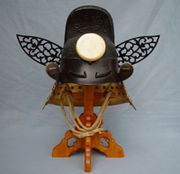
Kabuto
Encyclopedia

Helmet
A helmet is a form of protective gear worn on the head to protect it from injuries.Ceremonial or symbolic helmets without protective function are sometimes used. The oldest known use of helmets was by Assyrian soldiers in 900BC, who wore thick leather or bronze helmets to protect the head from...
used with traditional Japan
Japan
Japan is an island nation in East Asia. Located in the Pacific Ocean, it lies to the east of the Sea of Japan, China, North Korea, South Korea and Russia, stretching from the Sea of Okhotsk in the north to the East China Sea and Taiwan in the south...
ese armour
Armour
Armour or armor is protective covering used to prevent damage from being inflicted to an object, individual or a vehicle through use of direct contact weapons or projectiles, usually during combat, or from damage caused by a potentially dangerous environment or action...
as worn by the samurai
Samurai
is the term for the military nobility of pre-industrial Japan. According to translator William Scott Wilson: "In Chinese, the character 侍 was originally a verb meaning to wait upon or accompany a person in the upper ranks of society, and this is also true of the original term in Japanese, saburau...
class and their retainers in feudal Japan.
Kabuto were a prominent and important part of the equipment of the bushi, and played a symbolic role, as well. This explains the number of expressions, sayings and codes related to them. A few examples follow:
- Katte kabuto no o o shimeyo ("Tighten the string of the kabuto after winning the war"): don't lower your efforts after succeeding. Could be compared to not to rest on one's laurels.
- kabuto o nugu ("to take off the kabuto"): to surrender.
Upon the return of general peace under the Tokugawa Shogunate in the Edo Period, armour became more elaborate and ceremonial. Many very luxurious armours were produced during this period. Fine armour continued to be produced up to the end of the Edo period in 1867, and slightly beyond. Later armours often emulated the garb of the romanticized Kamakura-Muromachi warriors.
Nowadays, smaller-sized Yoroi
O-yoroi
The Ō-Yoroi is a prominent example of early Japanese armor worn by the samurai class of feudal Japan. The term ō-yoroi means "great armor."-History:...
and kabuto are bought and kept by Japanese people as a personal interior collection or a seasonal home decoration item displayed during the Boys' Festival/May 5 for expressing the hope that each boy in the family will grow up healthy and strong.
History
Pre-samurai Japanese helmets from the 5th century have been found in excavated tombs. Called mabizashi-tuske kabuto (visor attached helmet), the style of these ancient helmets came from China and Korea and they had a pronounced central ridge.Construction and types
A typical kabuto features a strong bowl (hachi), which protects the crown of the head, a suspended series of articulated plates (shikoro) to protect the neck, and various crests (datemono).A kabuto was usually constructed from three to over a hundred metal plates (tate hagi-no-ita) , riveted together. The rivets (hoshi) that secure the metal plates (tate hagi-no-ita) of the kabuto to each other could be raised, creating a form known as hoshi-bachi, or hammered flat, leaving only the flanges of the plates protruding, a form known as suji-bachi, hari bachi kabuto had no flanges showing and the rivets are filed flush. Some of the finer helmets were signed by smiths, usually from one of several known families, such as the Myochin, Saotome, Haruta, Unkai, and Nagasone.
On most types of kabuto the plates are arranged vertically, and radiate from an opening in the top called the tehen or hachiman-za (seat of the war god, Hachiman
Hachiman
In Japanese mythology, is the Japanese syncretic god of archery and war, incorporating elements from both Shinto and Buddhism. Although often called the god of war, he is more correctly defined as the tutelary god of warriors. He is also divine protector of Japan and the Japanese people...
). It is thought that one purpose of the tehen was for the warrior to pass his top knot
Chonmage
The chonmage is a form of Japanese traditional haircut worn by men. It is most commonly associated with the Edo Period and samurai, and in recent times with sumo wrestlers...
through. Although this usage was largely abandoned after the Kamakura-Muromachi period, Other possible reasons for the tehen could have been for ventilation or just the result of how the plates were riveted together. The tehen remained as a feature of most helmets, and was decorated with a tehen kanamono, or rings of intricately-worked, soft metal bands surrounding the opening of the tehen which usually resembled a Chrysanthemum.Zunari kabuto and momonari kabuto did not usually have a tehan.
Most kabuto incorporate a suspended neck guard called a shikoro. This is usually composed of 3 to 7 semi-circular lacquered metal or oxhide lames, attached and articulated by silk or leather lacing (odoshi) although some shikoro were composed of 100 or more small metal scales (kozane) in a row. This system of lames is the standard technology of defense employed, along with chain armour (kusari), for the body protection in Japanese armour. The shikoro could also be made from panels of cloth with chain armor (kusari) sewn to the cloth (kusari shikoro).
Kabuto would be secured to the head by a chin cord (shinobi-no-o) that would usually be tied to the various posts and or hooks of the facial armour (mengu) and the kabuto would have a cloth lining (ukebari).
Kabuto are often adorned with crests called datemono, there were four types of crests, maedate (front crest), wakidate (side crests), kashiradate (top crest}, ushirodate (rear crest). These can be family or clan emblems, or flat or sculptural objects representing animals, mythical entities, prayers or other symbols. Horns are particularly common, and many kabuto sport kuwagata, or stylized deer horns.

